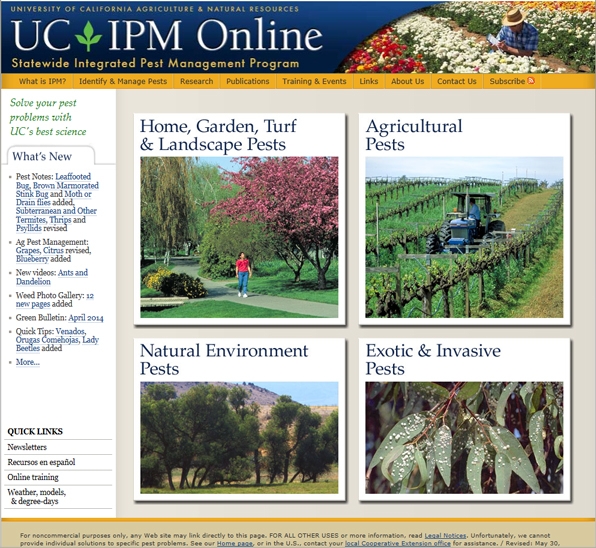Pests are an unavoidable part of growing plants or raising animals. Many times, pests are not considered until infestations/infections have become damaging. At such late stages, pesticides may be used to manage these pest issues. Pesticide applications have the potential to negatively impact the local environment and community due to health concerns, nontarget effects (impacts on organisms other than the pests), and contamination of air, soil, groundwater, and surface water. Proponents of urban agriculture may espouse the idea that pests will not be problematic when growing crops or raising livestock organically or "naturally". Such "balance of nature" may exist in natural systems, but agriculture represents a manipulation of nature and will always be subject to some degree of pest pressure.
Additionally, unbeknownst to or misunderstood by some urban farmers, commercial producers of "organic" foods may make just as many applications (or more) of pesticides as their "conventional" counterparts, using materials approved for organic use. Organic pesticides, though usually representing reduced environmental risk and persistence, can nonetheless pose the same hazards discussed above.
Integrated pest management (IPM) has the potential to mitigate some of these concerns. Many have heard the acronym IPM, but few can correctly articulate its meaning. Some folks think that IPM refers to pest management without pesticides…others believe it refers to a reliance on reduced-risk pesticides. Confounding this lack of understanding, each institution or organization seems to offer its own definition of IPM. Upon closer inspection, however, these seemingly disparate definitions all share common themes. Let's now examine the conceptual decision-making process of IPM using the step-wise central tenets of all true IPM programs.
- Education: For pest management to be effective, we need to know a bit about the pest. This means ensuring proper identification of new pests, understanding pest biology and ecology, and knowing what pests to expect in certain situations.
- Prevention: Preventing pests from becoming problems in the first place is a very important theme within IPM. This may involve planting resistant varieties or planting during certain seasons, ensuring proper care and maintenance so that plant/animal immune systems are robust, following proper sanitation protocols, and temporarily quarantining new arrivals to the production area to allow for inspection.
- Monitoring: There must be some way to determine whether pests are present or absent and whether pest density is increasing or decreasing. Monitoring can be as simple as manual/visual inspection during a farm walk or could be as complex as a pest-specific pheromone trapping program. Monitoring requires knowledge about pest biology and ecology and should be done on a regular basis so that data can be compared across time and space.
- Thresholds: There exists, for all pests and situations, some pest density at which commodities will be damaged (damage threshold) or money will be lost (economic threshold) and at which action must be taken to avoid these losses (action threshold). Below these thresholds, pests may not need to be managed at all; predators and parasites often keep pests naturally in check. Once thresholds are reached, as evident through monitoring data, action must be taken.
- Multiple Tactics: Taking action in IPM means using multiple tactics (methods); reliance on a single tactic never qualifies as IPM. Available tactics should be used in an order of "escalating force" such that the most benign approaches are considered and employed first. Physical tactics, such as hand-pulling or cultivation of weeds, should come before biological tactics, such as biological control agents and biopesticides. Chemical tactics (i.e. pesticides) should be considered as the last resorts but may certainly be necessary if other approaches have failed.
- Integration: No tactic used should interfere with another. For instance, application of a broad-spectrum insecticide targeting aphids may also kill predatory beetles feeding on the aphids.
- Evaluation: All good IPM programs have an evaluation component, where practitioners consider whether their approach was successful. What worked? What didn't work? Are pests still a problem? What might we do differently next time? This evaluation process feeds back into the "Education" component of IPM, creating a feedback loop and informing IPM practitioners for the next time they do battle with the same pest.
This decision-making process can be used to successfully manage any pest in any situation, whether it's weeds in a garden bed, rats in an attic, or rot fungi in fruit. To learn more about pest-specific IPM programs, visit these UC IPM web pages:
- UC IPM Online - Vegetables and Melons
- UC IPM Online - Fruit trees, nuts, berries, & grapevines
- UC IPM Online - Pest Notes Library
